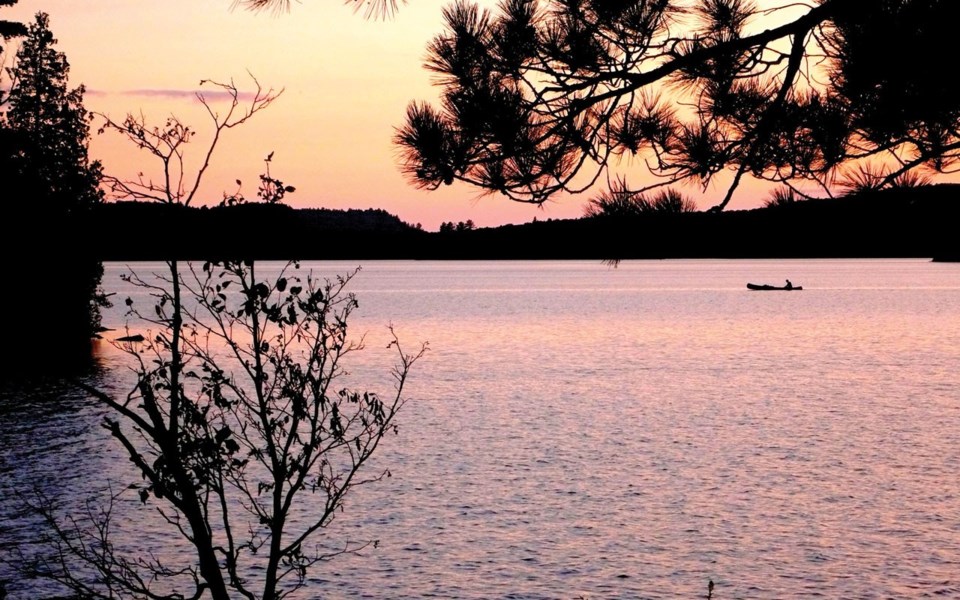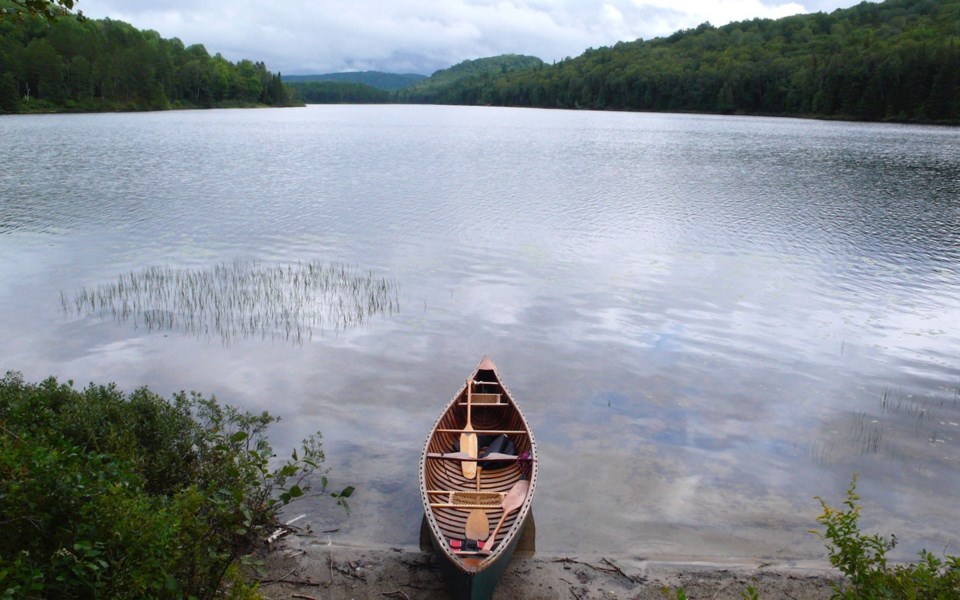
Before Neegik sailed across the Prairies, tacking west against a 40-knot wind. Before it suffered the indulgences of a venerate attempting to reclaim his youth. Before it resided near the sandy beach and played with laughing children. Before it traversed Algonquin Park south to north and south again one year, then south to north and onward to Temagami the next. Before the years spent mentoring a city boy in the ways and means of bushcraft. Before all that, Neegik was a blueprint on a drawing board.
Since 1914, Les Canots Tremblay Ltee. of St. Felicien, in the Lac St. Jean area of Quebec, had manufactured classic cedar-strip canoes ranging in length from 14 to 20 feet (four to six metres) known as the Chibougamau line. The sixteen-foot (4.9 m) version was a Huron. In 1972, I was gifted a red Huron for my 15th birthday. I named it Neegik ("otter" in Ojibwa). It changed my life.
As the oldest manufacturer of canvas-covered canoes in Canada, Tremblay's were of surpassing quality, in my day coated in a tough new vinyl-canvas laminate known as Verolite™®. Appropriately for the territories it would ply, Neegik was built to handle rough or fast waters, with a 36" (91 centimetres) beam, 12.5" (32 cm) depth, and 1" (2.5 cm) keel to effect maximum stability. I'd eventually replaced its rawhide-lattice seats with woven lace versions, and swapped out the centre thwart for a mahogany carrying yoke. In the mid-1980s, after a decade of rugged tripping and abusive whitewater had left Neegik bruised and beaten, I'd undertaken an amateurish restoration with a friend. We tossed the heavily scarred and UV-faded Verolite, replaced broken ribs, and re-covered the boat in standard heavy canvas, painting it forest green; we also removed the mangled keel, rationalizing that the craft worked better as a fast-turning solo boat (as she was mostly then employed). As a non-essential element, a keel could always be replaced sometime in the future. Some 25 years later, I did just that prior to a two-week canoe trip with my daughter.
Neegik—whose name I inexplicably fixed to the bow with the kind of brassy, peel-and-stick letters you might see on someone's mailbox—was my first real possession. It also became my companion, and canoeing—both act and history—my adolescent obsession. I revered Bill Mason, the great doyen of Canadian canoeing, whose famous book, Path of the Paddle, stated: "The canoe is the simplest, most functional, yet aesthetically pleasing object ever created. In my opinion this is not a statement that is open to debate." So immersed was I in this craft, that in bowed homage I undertook a semester-long project of building a scale-model birchbark canoe in art class to understand the process.
As a marvel of easy, low-drag propulsion, the canoe is humankind's default watercraft. Dugouts are most common because they're easiest to build, requiring only a single tree of floaty, workable wood. Otherwise, skin-covered kayak and umiak, as well as moosehide- and bark-covered canoes, reflect the various logic of the lands in which they were conceived. Offering lightness and mobility dugouts cannot, they're means to navigate a truly terraqueous geography—part liquid, part solid. The featherlight birchbark canoe is the acme of this art: you can snap any of its individual components easily in your hands, yet when these same elements are well assembled, the vessel is as strong as any—a model of fragile materials made strong through strategic bonds and parts that seem naturally to go together, but which require attention and care to make work. A metaphor for pretty much anything of value, in which the sheer beauty, effervescence and élan of the finished product belie an inherent strength and resilience.

Though the origins of its bauplan are lost in prehistory, one quality of a wood-framed canoe is obvious to anyone who thinks on such things—the striking similarity of its hull to the thoracic structure of a vertebrate animal, something well-familiar to any hunting peoples. Bark, skin, or canvas are stretched over wooden ribs braced by sternum thwarts and anchored by a central, spinal keel. Planking is the musculature; sinew and root lashings, brass screws and nails the ligaments and tendons. Given the many animal-skin boat designs worldwide, one can even imagine the not-so-far-fetched notion of paddling an empty carcass that may have preceded it.
For the 20 years I've lived in Whistler, Neegik resided at the family cottage in Haliburton, Ontario. Most summers I've gone back east, and had a chance for a reacquaintance paddle or two, sometimes even a full-fledged trip. And though I've often thought about bringing it home with me, that somehow never came to pass.
This summer, however, my brother sold the cottage and forced my hand. Arming myself with a roof rack, I drove east in early September, and after various other machinations both professional and personal, strapped a now-battered, somewhat neglected Neegik to the roof in early October. Four mad-driving days later we were in Whistler.
The Tremblay Canoe Company is long gone, victim of a government attempt to scale up production of an artisan process that couldn't be rushed. But from a century-old blueprint in Quebec to the West Coast, Neegik is nevertheless ready for a new chapter to begin.
Leslie Anthony is a biologist, writer and author of several popular books on environmental science.



